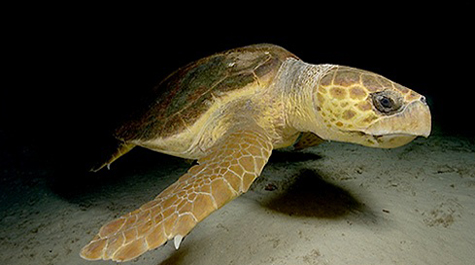Loggerhead sea turtles proposed for endangered listing
Two federal agencies have proposed to list the East Coast population of loggerhead sea turtles as an endangered species. Loggerheads are the most common sea turtles in Chesapeake Bay.
The proposal, filed jointly on March 10th by NOAA's National Marine Fisheries Service and the U.S. Fish and Wildlife Service, is informed by research conducted by VIMS emeritus professor Jack Musick and the 6 other members of the joint NMFS/USFWS Loggerhead Recovery Team. Musick terms the team's 4-year effort "one of the most thorough endangered species studies ever done."
Public comments on the proposed listing (identified by RIN 0648—AY49) will be accepted through June 14, 2010. Public hearings requests must be submitted by June 1.
The entire worldwide population of loggerheads is currently listed as threatened, with federal protections in place in U.S. waters since the species' 1978 inclusion on the threatened species list. The recent proposal would divide the worldwide population into 9 geographic sub-populations, with 7 of those proposed for an endangered listing (the other 2 would retain their threatened status).
One of the 7 subpopulations inhabits the northwest Atlantic. These turtles nest mainly along the southeastern coast of the U.S.; juveniles then ride the Gulf Stream into the North Atlantic, where they spend 6-12 years before returning to U.S. coastal waters. These older juveniles migrate seasonally along the continental shelf; some enter Chesapeake Bay each spring to feed on crabs, snails, fish, and sea grasses. Loggerheads reach sexual maturity at 20-30 years of age, with most of the older turtles staying to the south near their home nesting beaches. Adult loggerheads can reach more than 3 feet from nose to tail and weigh up to 400 pounds.
Population Declines
The proposed endangered listing reflects clear evidence of population declines among these northwest Atlantic loggerheads. Musick and other members of the Loggerhead Recovery Team report that nest numbers in Florida, where 90% of nesting for the population takes place, declined by 26% between 1989 and 2008. Data from the last decade shows an even steeper rate of decline, with 41% fewer nests now than in 1998.
Aerial surveys of loggerheads in Chesapeake Bay—flown by Musick and his graduate students during the 1980s, in 1994, and again between 2001 and 2004—confirm the Florida findings. The surveys, part of VIMS' ongoing Sea Turtle Stranding Program, suggest that the Bay's loggerhead population has fallen by almost 70% during the last 30 years.
Musick says these trends are troubling, particularly in light of the population's initial recovery following its listing as a threatened species in 1978. "There are still tens of thousands of loggerheads along the U.S East Coast," says Musick, "but their recent decline is alarming given that their recovery has reversed."
Threats
He also notes that the recent decline in nesting females could have its origins in events that began 15-20 years ago, when today's nesting females first left their home beaches for open-ocean waters near the Azores. That's where a major long-line fishery operates for tuna, swordfish, and blue sharks.
"Numerous countries are involved in this pelagic long-line fishery," says Musick, "with Spain having the largest fleet. Bycatch in this fishery is the single biggest threat facing these turtles."
In U.S. waters, threats to loggerheads include accidental capture and drowning in trawl nets, pound nets, and large-mesh gill nets. Dredging for navigational channels can also affect the turtles, as can human activities on loggerhead nesting beaches.
"The U.S. has done a lot to offset sea-turtle mortality," says Musick, "with a good example being the excluder devices employed by the shrimp fleet—those work pretty well."
Musick expects that an endangered species listing would further strengthen these protections. Future protections would likely involve more stringent enforcement of current regulations, decreases in the number of incidental turtle captures allowed during fishing for other species, and seasonal limits on dredging operations along the U.S. Atlantic coastline.
















